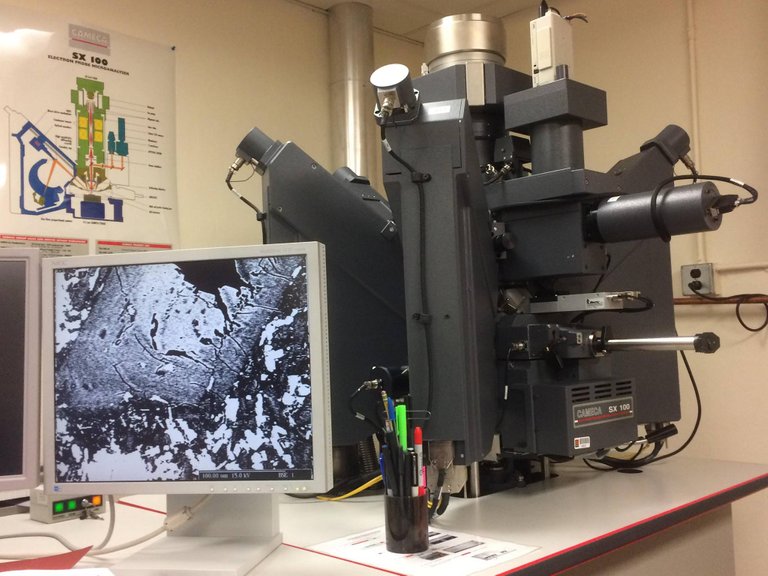I've been super busy with university this term, 17 credit hours that include physics, integral calculus, petrology, and sediment and stratigraphy; All of which have been keeping me indoors looking at rock samples or plugging and chugging equations in the undergrad lounge. This hasn't left much time for sharing my experiences through posting but I have been curating a little content each weekend that I will eventually get around to once the backlog is cleared.
All that aside last Friday I had the opportunity to use a electron micro-probe for a group project for my petrology class. Petrology is the branch of geology that is concerned with origin, small-scale structure, and composition of rocks. Basically classifying rocks on their mineral composition or percent compositions of parts that make up the whole rock. The three main rock types are, igneous, metamorphic, and sedimentary. These each have many different sub-groups, but ever rock falls under these three categories. Igneous rocks are formed by the cooling and solidification of lava(above ground) or magma(below ground). Sedimentary rocks are formed from the deposition and solidification of sediments such as gravel or sand. Metamorphic rocks are formed by the alteration without liquification(melting) of pre-existing rocks through temperature, pressure, or chemical leeching or enrichment.
For our class project each group is analyzing a sample of igneous rock from Mt. Jefferson in the Oregon Cascade range. The samples were taken from different lava flows around Mt. Jefferson so each sample will have a unique chemical signature. The chemical signature will tell us if the lava flows come from a homogeneous magma source or possibly from multiple isolated magma sources.
To determine the chemical composition we will be analyzing plagioclase crystals. Plagioclase is a range of chemical compositions known as the plagioclase feldspar series. This means there are two different chemical end-members and the plagioclase crystal could be composed of one or some ratio of the two depending on its source.
The end member chemicals for plagioclase are calcium and sodium. The names respectively of those end-members are anorthite and albite. Their chemical formulas are slightly different to stay balanced, anorthite-CaAl2Si2O8 and albite-NaAlSi3O8. When composed of a ratio of the two end-members there are specific names depending on percent content as shown in the figure at the bottom of the page.
Our goal for the project is to analyze different crystals from our samples to determine their composition through measuring percent anorthite content. The microprobe is pictured below with one of our plagioclase crystals on the screen be prepared for analysis. The photo doesn't show it but there are distinct color bands within the crystal showing a change in the magma composition ranging from albite to anorthite as components were crystallized and removed. So for our crystals we choose a point in the center of the crystal, A. Then we choose a point at the edge of the long axis, A'. The machine then blasts electrons at the sample at various points along the A-A' line. From the data anorthite composition can be found through calculating its weight%.

Photo I took while picking sample points.
We just started our projects so there isn't much to report yet other that background information and a little bit about our goals for the project. Our data was just posted today and we haven't had time to analyze or look at it but I'll post again as this project moves along through the rest of the term. Thanks for taking the time to read this, I appreciate it!
Science is badass!!!!!!
B
Solid solution ternary diagram for plagioclase feldspar and alkali feldspar. The tips of the triangles signify 100% of that composition, 50% is directly between the triangle tips along the edge. Our project is solely looking at the plagioclase which is represented by the bottom of this triangle.

photo sourced from http://www.people.carleton.edu/~bhaileab/IntroductionToGeology/Minerals/Plagioclase/Plagioclase.dwt
Congratulations @larrabeb! You received a personal award!
Click here to view your Board of Honor
Do not miss the last post from @steemitboard:
Congratulations @larrabeb! You received a personal award!
You can view your badges on your Steem Board and compare to others on the Steem Ranking
Vote for @Steemitboard as a witness to get one more award and increased upvotes!